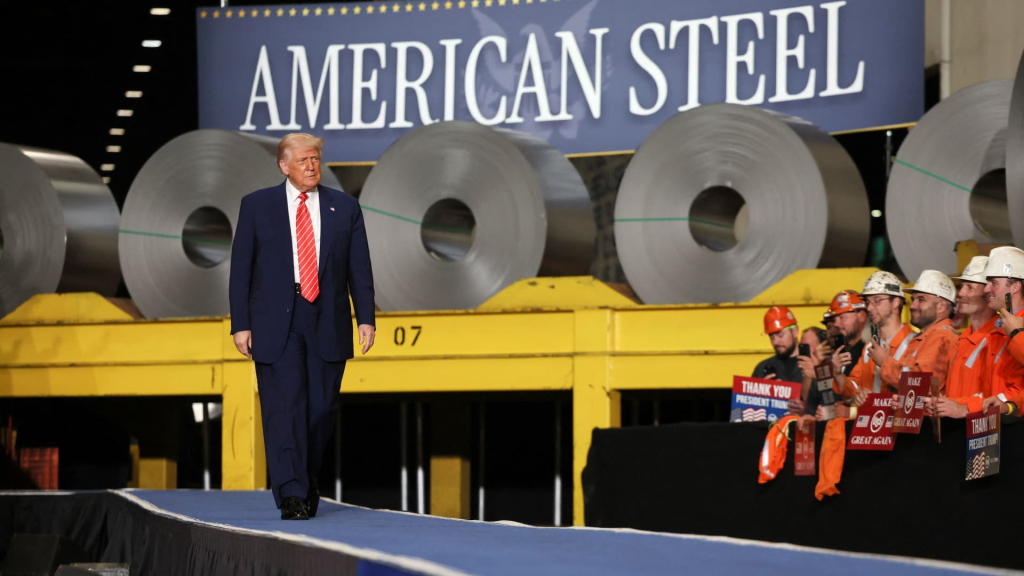President Donald Trump’s recent tariffs affecting over a dozen nations have ignited a wave of concern regarding potential trade moves specific to individual countries. However, much attention is warranted for the existing tariffs on particular products and commodities that could soon expand.
Known as “Section 232” tariffs, these levies have already been implemented on vehicles, steel, and aluminum, with copper and other materials being considered. Such tariffs amplify challenges for businesses and foreign trading partners striving to adapt within a rapidly changing trade landscape.
On Tuesday, Trump announced the imposition of a 50% tariff on copper imports, effectively doubling the initial proposal for this critical commodity. He also indicated that tariffs “at a very high rate” on pharmaceuticals would be forthcoming.
The announcement sent copper prices soaring, resulting in the metal experiencing its largest single-day increase since 1989. By the end of the trading day, the September copper futures contract rose by 13%, settling at $5.6855 per pound.
This move underscores the president’s readiness to wield sector-specific tariffs to negotiate terms with trading partners and potentially recalibrate the U.S. economy.
The new tariff measures were unveiled a day after Trump announced high tariffs on imports from 14 countries, effective August 1: Japan, South Korea, Malaysia, Kazakhstan, South Africa, Laos, Myanmar, Bosnia and Herzegovina, Tunisia, Indonesia, Bangladesh, Serbia, Cambodia, and Thailand.
These measures aim to increase pressure on U.S. trade partners to negotiate before the impending August deadline.
As negotiations remain uncertain—with some countries seeking exemptions amid mixed responses from the White House—specific tariffs are already impacting trading partners and American consumers alike.
South Africa and Kazakhstan, both key aluminum producers, along with major steel producers Japan and South Korea, have been heavily affected by the recent tariff announcements.
“While reciprocal tariffs capture headlines, the product-specific tariffs will have a substantial impact on the domestic market,” said Mike Lowell, a partner at law firm ReedSmith, during an interview with Finance Newso.
High rates and no delays
In June, Trump had already declared a doubling of tariffs on steel and aluminum imports to 50% for most countries, set to take effect the following day.
Steel and aluminum are critical components not only in the manufacturing of durable goods such as refrigerators and automobiles but also in everyday items like zippers and kitchenware.
The recent tariffs are a continuation of Trump’s previous trade policies implemented during his first term, which began with a 25% tariff on steel and a 10% tariff on aluminum imports in 2018, leading to rapid price hikes, as reported by Reuters.
However, the current tariff structure significantly differs from those earlier policies in crucial aspects. Notably, these rates are considerably higher—often double their former levels—and are compounded by additional customs duties.
“The combined use of Section 232 alongside other tariff measures has introduced further complexity to the tariff situation, elevating the necessity for countries to negotiate exemptions,” Iacob Koch-Weser, associate director of global trade and investment at BCG, noted in a report last month.
Trump has consistently utilized Section 232 of the 1962 Trade Expansion Act to defend his sector-specific tariffs, allowing for unilateral adjustments in tariff rates when national security is deemed at risk.
Conversely, Section 301 has been employed to impose tariffs on specific goods from China, many of which originated during Trump’s first term and continued under President Joe Biden’s administration.
Another area impacted significantly by these specific tariffs is the automotive sector, facing a 25% tariff rate that heavily affects major exporters, particularly Japan and South Korea.
Intense lobbying from industry representatives has prompted the White House to contemplate potential exemptions from these auto tariffs for certain companies, as highlighted by Finance Newso.
Earlier in April, the administration issued an executive order preventing the stacking of auto tariffs with existing levies on aluminum and steel, providing some relief to the auto sector.
However, as supply chains tend to react gradually to regulatory changes, the effects of Trump’s automotive tariffs may not be fully realized for years to come.
Broad presidential authority
Analysts have pointed out that Trump’s authority to impose and alter tariffs is more robust concerning sector-specific imports than for his country-specific rates based on reciprocity.
“Section 232 tariffs lie at the heart of President Trump’s tariff approach,” acknowledged Lowell from ReedSmith.
“These tariffs are less susceptible to ongoing litigation and are more likely to withstand legal challenges, thereby remaining relevant even with changes in presidential administration—much like the aluminum and steel tariffs established in Trump’s first term,” he stated.
To rationalize the country-by-country tariffs introduced earlier this year, Trump leveraged emergency powers that are currently under scrutiny in federal court. Should he face setbacks in that legal battle, he may revert to relying on sector tariffs as an alternative approach to wield U.S. economic influence.
Moreover, Trump has signaled the potential for forthcoming sector-specific tariffs on a variety of goods, including agricultural products, iPhones, and trucks, though no formal actions have yet been undertaken.
Previously, he directed the Commerce Department to conduct a Section 232 national security investigation into copper and lumber imports, with results expected by November.
However, the comments made Tuesday indicate that substantial tariffs could be implemented much sooner.
“Today, we’re addressing copper,” Trump stated, referring to the metal that is integral to electrical wiring in homes across the nation.


























